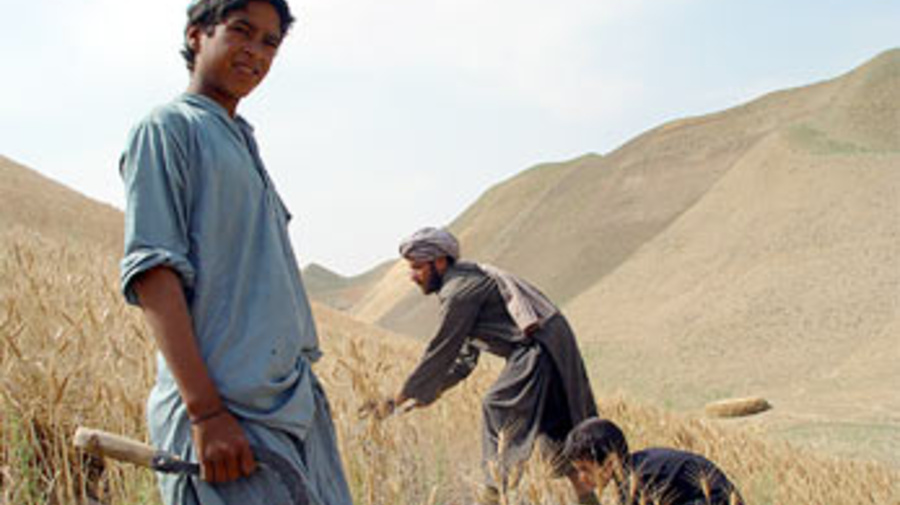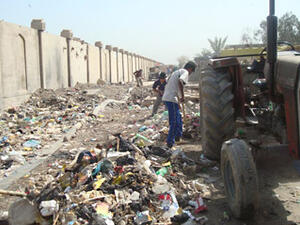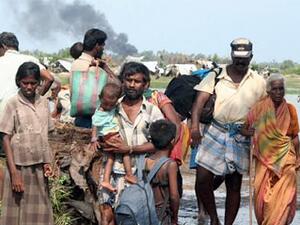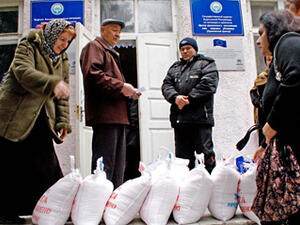Feature: Displaced by drought, Afghans now rush back to lush hills
Feature: Displaced by drought, Afghans now rush back to lush hills

Afghans in Badghis province can look forward to a hopeful harvest now that the long drought has ended.
QALA-I-NAW, Afghanistan (UNHCR) - In the remote province of Badghis, western Afghanistan, tens of thousands of displaced people are returning to their homes amid what seems to be the end of a long and devastating drought that had forced them to leave in the last few years.
With much rainfall and snow during 2002 and 2003, the rolling hills in Badghis are full of endless wheat fields and livestock this year.
In Qala-i-Naw, the main town of Badghis province, a returnee family has been busy working in their wheat fields. Mohammad Hussein, 30, and his two sons are drenched in the summer heat, but their happiness was palpable.
"We came back from Maslakh camp last spring and an aid agency gave us some seeds and tools," says Mohammad. "I think this year's harvest will be just as good as that of 10 years ago."
Over the past few years, the western provinces of Badghis and Ghor had been severely affected by drought, prompting tens of thousands of families like Mohammad's to walk for months to reach Herat or Kandahar cities in search of food. This, together with displacement caused by the war against the Taliban in late 2001, caused three main camps for displaced Afghans near Herat to swell to about 200,000 people.
This year, UNHCR's twice-weekly return convoys have rapidly decreased the displaced population in western Afghanistan. More than 74,000 people have returned voluntarily to Badghis province alone, leaving about 22,000 Afghans in Herat's camps.
While the conditions for return have improved for the drought-affected people, many families still cannot return, fearing harassment and abuses in their home villages.
Badghis is a remote yet strategic province. Accessible by an excuse of a road between Herat and Mazar-i-Sharif that winds through dry riverbeds and canyon tops, it nonetheless lies in a contested area with a direct trade route to Central Asia. Its isolation and the lack of law and order allow gunmen to rule over civilians who typically fall prey to both local and larger factional powers.
Just this spring, three areas in Badghis province - Bale-Murghab, Ghormach and Sange-Tash - saw fierce battles between at least three factions competing for power after the fall of the Taliban. UNHCR received reports of illegal taxation, harassment, forced recruitment and in few cases, rape, by rogue soldiers and commanders preying on the civilians.
There have been fewer reports of human rights abuses in the past month, but UNHCR is concerned that the current drop in extortion and harassment cases is strongly tied to the recent harvesting of poppies in the area, which has boosted the local economy.
"We are worried that they will come again to harass us once they run out of money," said an elder in Akazai village, near the Turkmen border.
Particularly vulnerable are the pockets of Pashtun villages scattered in this region dominated by the ethnic Tajik and Uzbek majorities. They are the descendants of Pashtun tribes relocated from the south over a century ago to act as a buffer along the border with Central Asia. Seen as sympathisers of the fallen Taliban regime, Pashtuns often become a target.
"We want the central government to pay more attention to what is happening here," said a Pashtun villager. "We would like international forces to come here. We would even welcome the Americans."
Fearing larger powers in the region, the local authorities in the remote province also long for the presence of an international force.
But the current 5,000-strong international forces are unlikely to expand beyond Kabul. Also unlikely is the chance of Badghis becoming a priority area among all the trouble-spots in the country. But the heightened security concerns in recent months have prompted a debate among the Coalition countries for the deployment of Provincial Reconstruction Teams (PRT) outside the Afghan capital.
PRT troops are primarily responsible for rehabilitation and reconstruction work, but UNHCR believes their presence can help improve the security in isolated communities and help pave the way for many displaced families to return.
In Bamiyan, for example, the deployment of the American PRT to rebuild bridges and a university contributed greatly to stability in the area. Combined with the presence of the Afghan National Army in the region, it has allowed hundreds of Tajik families to return to majority Hazara villages.
But for many of the estimated 220,000 internally displaced Afghans country-wide, return and reconciliation back home may take some time yet. Attacks on Pashtuns in the north are only a recent trend in the cycle of violence between ethnic and factional groups that has gone on for centuries.

Wheat-covered hills on the road between Qala-i-Naw and Bal-e-Murghab. Remote but strategic, Badghis province offers a bountiful return for displaced Afghans.
In a tented camp near Qala-i-Naw, while listening to displaced Pashtuns complaining bitterly about past abuses committed by the ethnic Uzbeks, UNHCR's Chief of Afghan Mission Filippo Grandi said, "But if you don't forget the past, your children will have no future."
The crowd fell silent.
By Maki Shinohara
UNHCR Afghanistan









